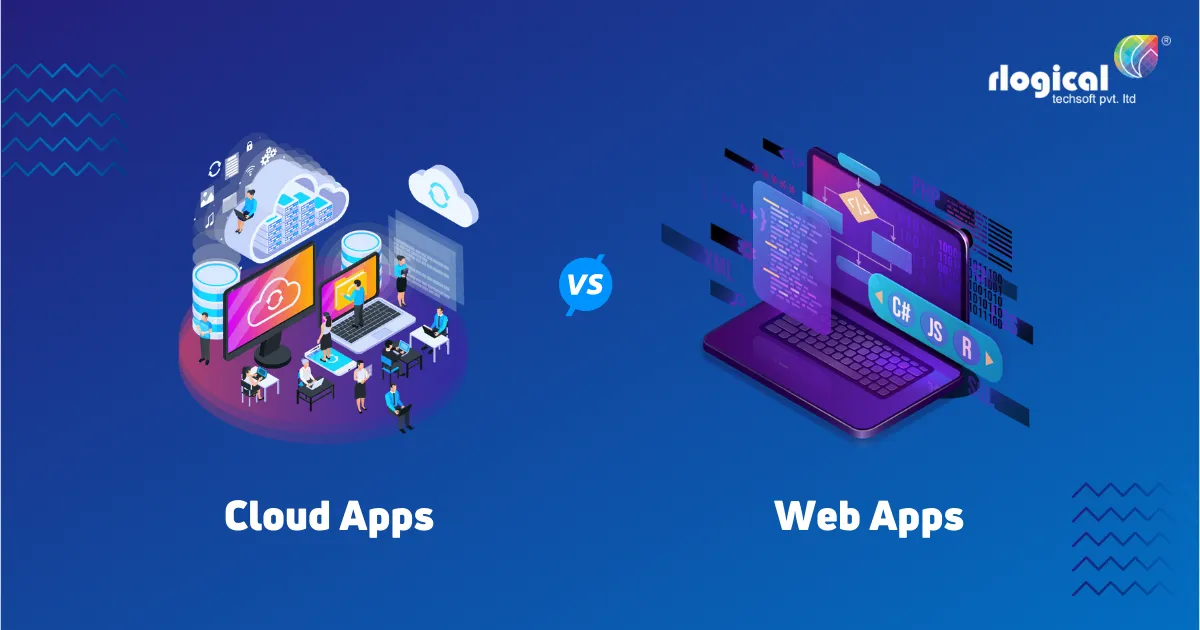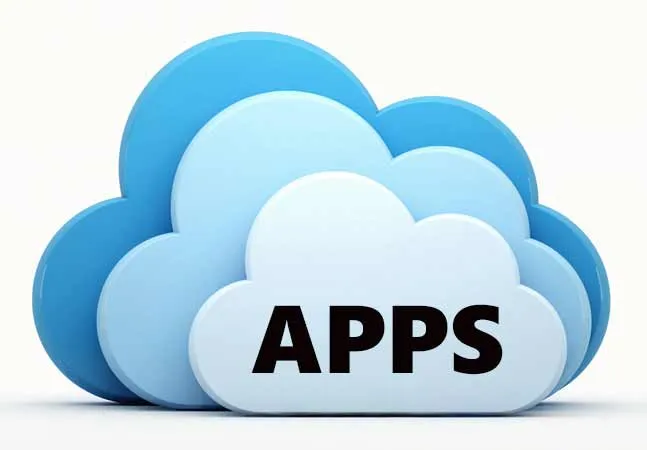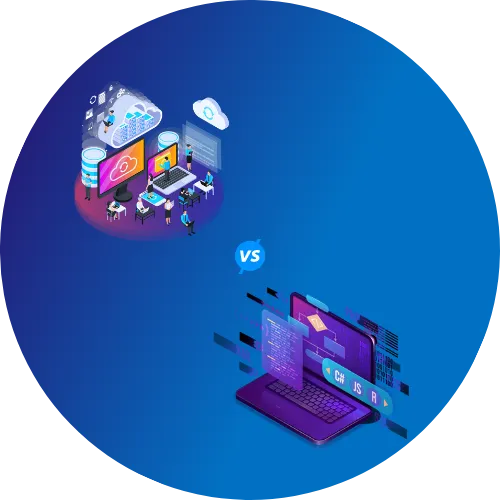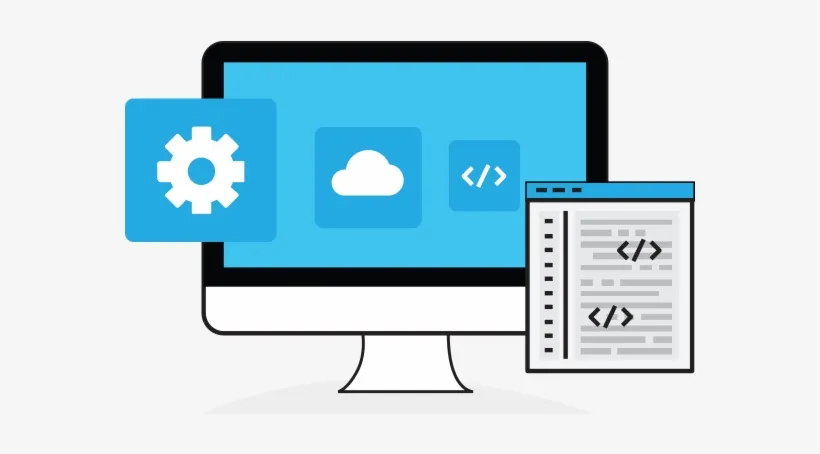
Perhaps you have come across the terms “web apps” and “cloud apps” being used interchangeably despite referring to different things. It is natural for you to get confused, given that these types of web-based apps are almost identical. In the following paragraphs, we have mentioned the primary differences between cloud apps and web apps, along with their respective pros and cons.
What exactly are web apps?
These web-based apps rely on Web servers and have been designed to be used on web browsers exclusively. On most occasions, they come with simple architecture while providing limited customization as well. Web apps are known to combine client-side scripting and server-side scripting, in which case the client will depend on the Web server for assessing the services. E-commerce applications and e-banking are some examples of these types of apps.
Web apps are divided into five groups: dynamic, static, portal, animated and content management systems, and e-commerce. The most basic is the static web apps, which are so-called since their content remains the same over time. As compared to static web apps, dynamic web apps happen to be more complicated and come with the possibility of regularly modifying or updating the info held by them. Portable web apps allow users to access different types of pages via a home page, and e-commerce web apps development help in electronic payment collection. A CMS app is used for developing web apps that are being developed continually, such as news pages or personal blogs.
Web app pros
- It is quite simple to maintain web apps since a common code base is used by them across several platforms.
- It is possible to create web apps for all platforms so long as they can run in a web browser.
- Unlike other app types, web apps happen to be more inexpensive upfront.
- It is not imperative for the updates to these apps to go through an app store. This implies that there is no need for users to manually manage the apps. Once a web app is opened by a user, the most recent version will always load.
Web app cons
- The scope of web apps is much less in terms of leveraging hardware and device features.
- A web app cannot be run without a browser. The user must take more steps for using a web app.
- Users will be interacting with various web browsers, and the performance metrics and usage patterns used for creating a product roadmap happen to be more challenging in terms of collection.
- As compared to other app types, web apps are much less responsive as well as slower.
- Unlike native apps, web apps are less intuitive and less interactive.
- With web apps, the number of branding opportunities is quite less.
Must Read: Top 6 Reasons Why Choose Node.js for Web App Development in 2021
What exactly are cloud apps?

Despite being a web-based program, the data of cloud apps are sorted in a cloud. The primary difference between web apps and cloud apps is this.
Email service will be a proper example of a cloud app where the users will be interacting with the application using a web browser or a mobile gadget. The app’s data will be processed by the local device and cloud computing solution, implying that it is possible to access it online and offline.
On most occasions, cloud applications will be written in any one of these three categories: SaaS (Software as a Service), IaaS (Infrastructure as a Service), or PaaS (Platform as a Service). SaaS happens to be the most typical of these three, where a 3rd-party cloud provider will be managing and hosting the entire app. In IaaS cloud apps, the cloud infrastructure will be rented from a 3rd-party; however, they are in charge of app support, middleware, and apps. Lastly, PaaS cloud apps provide more freedom to the developers, given that they will be able to create and host the apps.
Cloud app pros
- Cloud apps allow people to share info easily and quickly, employing shared storage, and thus, they help enhance collaboration.
- Cloud enables us to easily access store info and quickly anytime anywhere by using an Internet connection.
- The production plus efficiency of an organization is increased by an internet cloud infrastructure by making certain that data is accessible at all times.
- These types of apps minimize software as well as hardware maintenance expenses for the companies.
- A huge storage capacity is offered by the cloud for storing important data like documents, audio, graphics, and video in a single place.
- One major benefit of cloud-based apps happens to be data security. Cloud helps to make sure that information is stored and handled safely.
Cloud app cons
- One of the biggest drawbacks of cloud apps is that companies might face problems while transferring their services between vendors.
- Cloud users do not have much control over the functionality and implementation of services within a cloud infrastructure.
- Even though top-notch security is offered by cloud service for storing essential info, it is important for you to recognize that you’re sending all the sensitive data of your company to a 3rd party before adopting cloud technology.
- Data is accessed by users from the cloud using an Internet connection. The users can’t access data in case the Internet connection is not up to the mark. Unfortunately, this is the only way to access information from the cloud.
Must Read: Azure vs AWS: Who is the winner in the Cloud Platform?
Comparison Table Between Web Apps vs Cloud Apps
Web Apps |
Cloud Apps |
| Work in browsers | Don’t depend on browsers |
| Can’t work offline | Can work offline |
| Limited scalability | Inherently scalable |
| Limited availability | Very up-time |
| Not all cloud apps are web apps | All cloud apps are web apps |
| Isolated – tenancy solution | Multi-tenancy solution |
| Only run on providers web servers | Can run on the users computing systems or providers web servers |
Below, we have mentioned some features which will help to differentiate between web apps and cloud apps.
- Structure is the main difference between the 2. While both of them need access to online services through the Internet, cloud apps don’t rely on web browsers for functioning at all times. It is possible to access cloud apps from just about anywhere. They can perform tasks from any local workstation.
- In general, web apps are not designed to have multi-tenancy capability; this implies that they do not support the customers’ different requirements. On the contrary, multi-tenancy is offered by cloud apps.
Cloud apps provide –
- Customization features for improving functionalities. Web apps do not provide an identical level of functionality.
- While the web apps can retrieve and verify the information of clients from the data servers of an enterprise, cloud apps will be able to improve security measures for making certain that cloud apps are safer.
Which one you ought to use?
The fact is that this will be depending on the app type that you want to develop. A cloud app will be ideal for you if you would like to develop an app with extensive customization and sharing abilities and a high storage load. Nevertheless, if your app is not that ambitious, and you are searching for something affordable without any launch restriction, then a web app will be appropriate for you.
Final thoughts:
As mentioned earlier, your choice of the type of app will depend largely on its requirements and purpose. However, the good news is that if you like to go for the web app, it is always possible to upgrade to the cloud app afterward.
Rahul Panchal
Rahul Panchal is the Founder & Managing Director at Rlogical Techsoft Pvt. Ltd. He is a pioneer tech enthusiast who has assisted diverse enterprise solutions with a fresh perspective over the years. From integrating technologies like Full-Stack, .NET, Flutter & PHP, he has harnessed custom web or hybrid mobile app development projects. His creative outlook on the latest models of AI, ML, blockchain, and IoT, has made various businesses attain leading-edge success.
Related Blog
- Progressive Web App Benefits for Your Business Growth in Future Market
- Build Innovative Web Apps with React and NodeJS [Expert’s Outlook]
- 12+ Top Examples of PWA (Progressive Web Applications) From Different Industry
- Top Reasons Why Choose Node.js for Web App Development?
- Learn Which Backend Framework Is Best Node JS Or Python
Categories
- All
- AI Development Services
- Amazon Web Services (AWS)
- ASP.Net Development
- Azure Web App
- Big Data Analytic
- Customize
- Digital Marketing
- Drupal Development
- E-commerce web development
- Education Mobile App Development
- Enterprise Application
- Event Management App Development
- Fintech
- Fitness App Development
- Food Delievery
- Front-End Development
- Grocery App Development
- Healthcare App Development
- Hire Dedicated Developers
- Hotel Booking App
- IT Industry
- JavaScript Development
- Mobile App Development
- On Demand App Development
- On Demand Healthcare App Development
- PHP Development
- POS Software Development
- Real Estate Mobile App Development
- Retail Business App Development
- Salesforce
- Social Media Development
- Software Development
- Technology
- Transportation App Development
- UI/UX Design
- Web Design
- Web Development
- Web Services
- Web/Data Scraping Services
- WordPress




 Rahul Panchal in Web App Development
Rahul Panchal in Web App Development 






